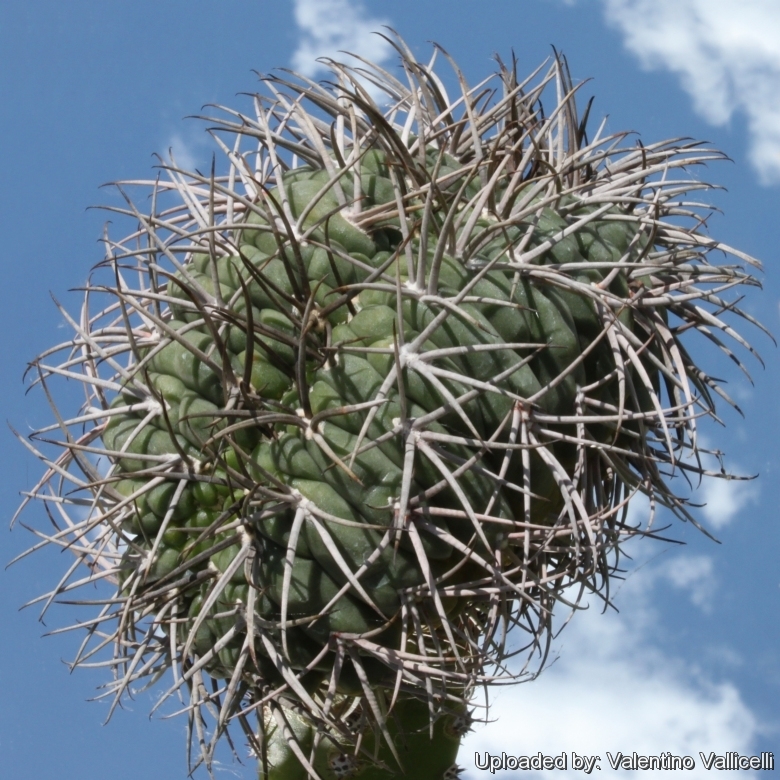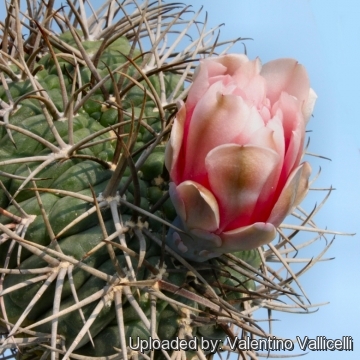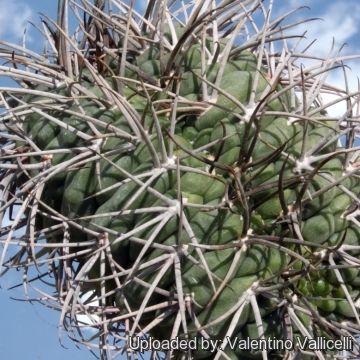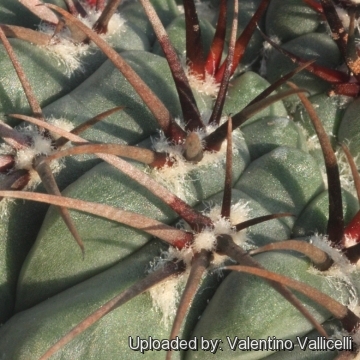




Your support is critical to our success.

Origin and Habitat: Nursery selected form (Japan)
Synonyms:
Description: This is a special crest form of Gymnocalycium cardenasianumSN|995]]SN|995]] selected in Japan. That distinguish for its with incredibly strong dark spines.
Stem: Grey green, compact with concave woolly apex.
Spines: Long, stout, eagle claw-shaped, typically-twisted, up to 4 cm long. Black turning dark grey as they ages.
Flowers: Open petaled, funnel-shaped, about 4(-7) cm in diameter, 3(-5) cm tall and pinkish in colour. They grow near the apex. The flowers of Gymnocalycium cardenasianumSN|995]]SN|995]] have a tough time trying to force themselves through the fierce spines, and is quite rare to see an open flower because the spines prevent the flowers from opening properly.
Blooming season: They will bloom at an early age and bloom sparingly in mid-summer.
Subspecies, varieties, forms and cultivars of plants belonging to the Gymnocalycium spegazzinii group
 Gymnocalycium cardenasianum cv. Japanese Selection: has long, stout spines, eagle claw-shaped, typically-twisted, up to 4 cm long. Black turning dark grey as they ages. It has been selected in Japan.
Gymnocalycium cardenasianum cv. Japanese Selection: has long, stout spines, eagle claw-shaped, typically-twisted, up to 4 cm long. Black turning dark grey as they ages. It has been selected in Japan. Gymnocalycium cardenasianum cv. Japanese Selection f. cristatum: is a beautiful crested form with stout black spines typically-twisted, eagle claw-shaped, up to 4 cm long. It has been selected in Japan.
Gymnocalycium cardenasianum cv. Japanese Selection f. cristatum: is a beautiful crested form with stout black spines typically-twisted, eagle claw-shaped, up to 4 cm long. It has been selected in Japan. Gymnocalycium spegazzinii Britton & Rose: is a flattened solitary cactus with very characteristic spines pointing sideways or downward. Distribution: North Argentina on hight altitude and Bolivia.
Gymnocalycium spegazzinii Britton & Rose: is a flattened solitary cactus with very characteristic spines pointing sideways or downward. Distribution: North Argentina on hight altitude and Bolivia.- Gymnocalycium spegazzinii subs. armatum (F.Ritter) Halda & Šorma
 Gymnocalycium spegazzinii subs. cardenasianum (F.Ritter) R.Kiesling & D.Metzing: is densely covered with incredibly strong twisted spines up to 6cm long, pointing sidewards and downward. Usually whitish or pale brown. Distribution: Bolivia (Tarija and Chuquisaca).
Gymnocalycium spegazzinii subs. cardenasianum (F.Ritter) R.Kiesling & D.Metzing: is densely covered with incredibly strong twisted spines up to 6cm long, pointing sidewards and downward. Usually whitish or pale brown. Distribution: Bolivia (Tarija and Chuquisaca). Gymnocalycium spegazzinii var. horizonthalonium Backeb.: is characterized by a variability in the length and shape of the spines and has received many names, leading to confusion with the entirely dissimilar Echinocactus horizonthalonius.
Gymnocalycium spegazzinii var. horizonthalonium Backeb.: is characterized by a variability in the length and shape of the spines and has received many names, leading to confusion with the entirely dissimilar Echinocactus horizonthalonius. - Gymnocalycium spegazzinii var. major Backeb.
 Gymnocalycium spegazzinii var. punillense H.Till & W.Till: The spines are typically recurved, add-pressed against the body, pointing downward and most attractive. Distribution: La Punilla (Argentina, Prov. Salta, Rio de Los Conchas)
Gymnocalycium spegazzinii var. punillense H.Till & W.Till: The spines are typically recurved, add-pressed against the body, pointing downward and most attractive. Distribution: La Punilla (Argentina, Prov. Salta, Rio de Los Conchas) Gymnocalycium spegazzinii subs. sarkae Halda & Milt: with different seeds, darker purple-brown epidermis and long spidery spines. Distribution: Argentina, Salta, San Felipe – La Angostura.
Gymnocalycium spegazzinii subs. sarkae Halda & Milt: with different seeds, darker purple-brown epidermis and long spidery spines. Distribution: Argentina, Salta, San Felipe – La Angostura. Gymnocalycium spegazzinii var. unguispinum Slaba: has only 5 short spines less than 1 cm long, stout, subulate, eagle claw-shaped, typically-twisted and curved gracefully outward and downward. Distribution: South of Puerta Tastil, Salta, Argentina.
Gymnocalycium spegazzinii var. unguispinum Slaba: has only 5 short spines less than 1 cm long, stout, subulate, eagle claw-shaped, typically-twisted and curved gracefully outward and downward. Distribution: South of Puerta Tastil, Salta, Argentina.

Gymnocalycium cardenasianum cv. Japanese Selection f. cristatum Photo by: Valentino Vallicelli

Gymnocalycium cardenasianum cv. Japanese Selection f. cristatum Photo by: Valentino Vallicelli

Gymnocalycium cardenasianum cv. Japanese Selection f. cristatum Photo by: Valentino Vallicelli

Gymnocalycium cardenasianum cv. Japanese Selection f. cristatum Photo by: Valentino Vallicelli
Cultivation and Propagation: It is not too difficult in a greenhouse, although grows quite slowly. It is usually seen as a grafted plant but grows on its own roots too.
Soil: Use mineral well permeable mineral soil with little organic matter (peat, humus). It prefers a low pH compost.
Exposure: The plant tolerates extremely bright situations (grow it hard, at a high position in the greenhouse, so plants will develop strong blak spines and will show a healthy, although slow growth.), but it enjoys some shade during the hottest part of the day in summer.
Watering: Water sparingly from March till October (weekly during summertime, if the weather is sunny enough), with a little fertilizer added. Less or no water during cold winter months, or when night temperatures remain below 10° to prevent root loss. It is sensitive to overwatering (rot prone).
Fertilization: Feeding may not be necessary at all if the compost is fresh then, feed in summer only if the plant hasn't been repotted recently. Do not feed the plants from September onwards as this can cause lush growth which can be fatal during the darker cold months.
Hardiness: Keep perfectly dry in winter at temperatures from 5 to 15 degrees centigrade. (but it is relatively cold resistant and hardy to -5° C, or possibly colder for short periods) In the rest period no high atmospheric humidity!! (Temperature Zone: USDA 9-11)
Crested growth: Unlike 'monstrose' varieties of plants, where the variation from normal growth is due to genetic mutation, crested growth can occur on normal plants. Sometimes it's due to variances in light intensity, or damage, but generally the causes are unknown. A crested plant may have some areas growing normally, and a cresting plant that looks like a brain, may revert to normal growth for no apparent reason. If you have any of the crested part left you need to remove the normal growth and leave the crested part behind this will need to be done regularly.
Propagation: Grafting or cuttings. Plants are usually grafted onto column-shaped cacti but proved to be able to produce their own roots if degrafted. Cuttings will take root in a minimum temperature of 20° C (but better in hot weather). Cuttings of healthy shoots can be taken in the spring and summer. Cut the stem with a sharp, sterile knife, leave the cutting in a warm, dry place for a week or weeks (depending on how thick the cutting is) until a callus forms over the wound. Once the callus forms, the cutting may be inserted in a container filled with firmed cactus potting mix topped with a surface layer of coarse grit. They should be placed in the coarse grit only; this prevents the cut end from becoming too wet and allows the roots to penetrate the rich compost underneath. The cuttings should root in 2 to 6 weeks. Large crested piece must be placed on the soil surface without burying the plant base down in the soil.
| Your Actions | |
|---|---|
| Back to Gymnocalycium index | |
| Back to Cactaceae index | |
 |
Back to Cacti Encyclopedia index |
Privacy stantement - Terms and conditions - How to cite - About us - Feedback - Donate




